Apollo 13
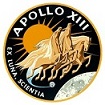
Postflight Activities
© 2020 Johannes Kemppanen and Frank J. O'Brien. All rights reserved.
Last updated 2020-04-21
This closing chapter of the Apollo 13 Flight Journal will explore events after the mission. We will look at the recovery and the crew reception, and the work that was done to find out just what exactly happened to cause the accident. A detailed exploration of the oxygen tank fault is part of this chapter, as well as a look at what the astronauts involved in the mission did next. Finally, we will look at the popular culture impact of the mission, and some of its depictions in the media and literature.
Recovery Operations
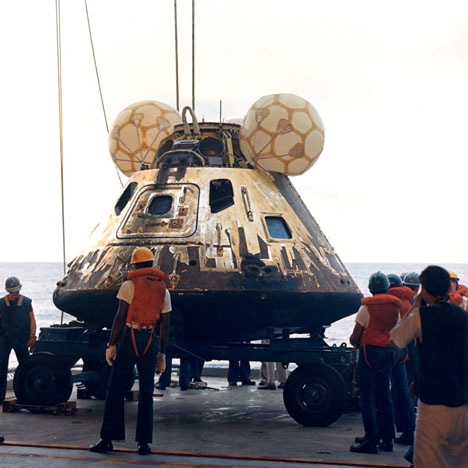
Odyssey is hoisted down to the deck of the Iwo Jima and onto the CM Dolly, which is a wheeled platform for transporting the Command Module. The uprighting system balloons are still inflated. Note the amount of yellow Kapton insulation that remains on the spacecraft.
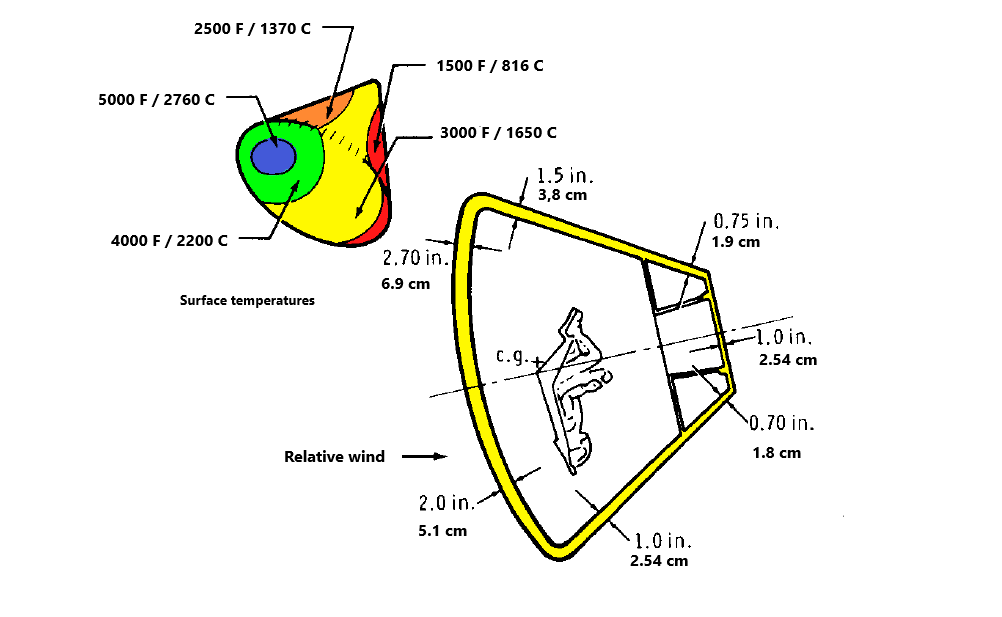
This diagram on the heat experienced by the Command Module during re-entry shows that the area where the Kapton insulation remained received the lowest temperature during the scorching re-entry. This section, containing the crew side hatch, would have faced opposite the direction of travel during re-entry. This was well known to the designers and meant that the heat shield was only 1 inch thick at this point, while it was 2.7 inches thick at the stagnation point on the opposite edge of the CM.
The postlanding phase of the mission was uneventful in terms of standard operations, besides the greater than usual excitement at the crew's successful return. The Command Module was lifted from the sea and taken onboard the USS Iwo Jima. Odyssey was offloaded in Hawaii on 24 April, and had its onboard systems deactivated for future transport at the Hickam Air Force Base. This process involved thorough photography and observation of the spacecraft, draining fuel and oxidizer remnants from the RCS tanks, and procuring samples from the onboard tanks, such as the drinking water tank. On 27 April, the spacecraft returned to the North American-Rockwell factory in Downey, California for thorough technical analysis by the manufacturer.
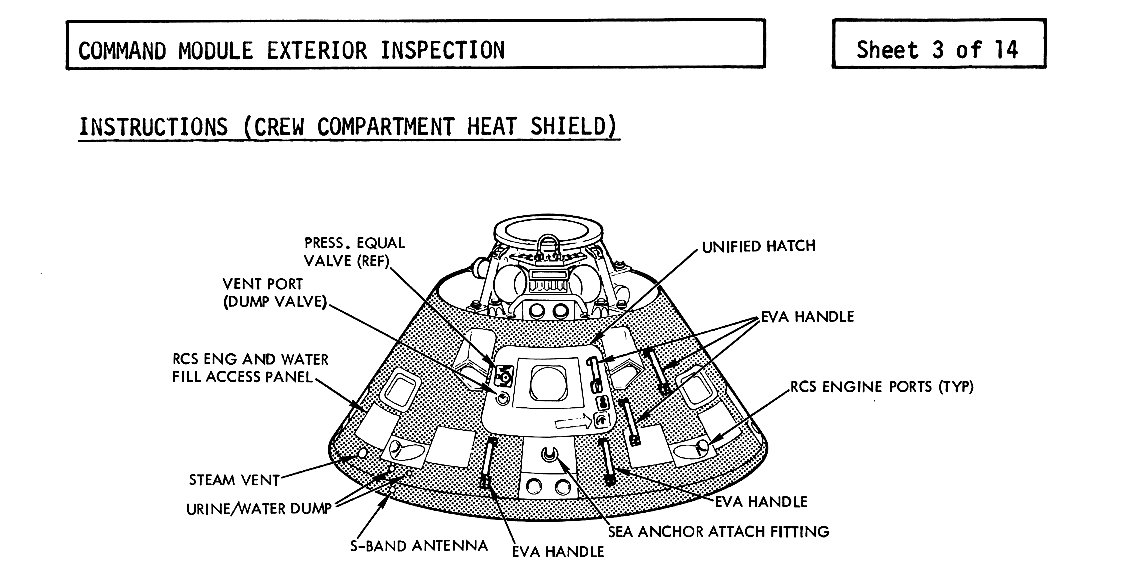
A sample diagram of external points of interest and inspection from the Recovery Manual. Every possible part of the spacecraft was examined for its condition post-flight.
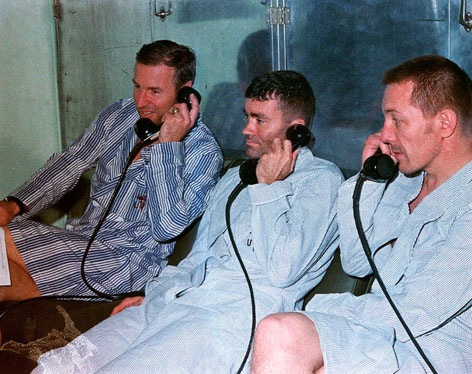
The crew of Apollo 13 receives a congratulatory phone call from President Nixon while in sickbay. Nixon consoled the crew by declaring the mission a success, despite the abort.
Upon arrival onboard the recovery ship, the crew was immediately taken to sickbay for medical examinations and possible treatment. The trio was found to be in mostly good health, although suffering from notable dehydration and extreme exhaustion. None of the three had had adequate sleep, water or food since the accident four days earlier. This was also reflected by the amount of weight they had lost, mostly as water due to the self-imposed strict water rationing. Lovell had lost 14 pounds (6.3 kg) while Swigert had lost 11 pounds (5 kg) and Haise lost 6.5 pounds (3 kg). Fred Haise was diagnosed with a bacterial urinary tract infection and required antibiotics treatment. He had been increasingly unwell during the last few days of the mission and was feverish during the final day. It is suspected that the infection could have become debilitating if the mission had lasted much longer. After a night's rest, the crew flew from the Iwo Jima first to Pago Pago at Samoa and from there to Hawaii.
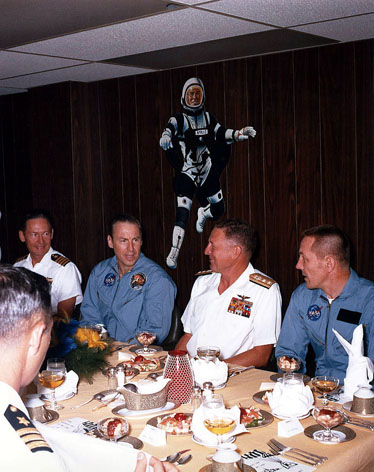
A banquet held for the crew onboard the Iwo Jima.
Hero's Welcome
The Apollo 13 crisis was noted at the highest level of US government as well. President Richard Nixon was alerted to the accident on the morning of April 14th by his Chief of Staff Haldeman and National Security Advisor Henry Kissinger. The President phoned NASA Administrator Thomas O. Paine several times, and also received further information from astronauts Frank Borman, Michael Collins and Bill Anders. Brief phone calls of support were also made to the families of the Apollo 13 astronauts. A White House party for the visiting Prime Minister of Denmark became a more sombre event as a result, with the planned evening's entertainment cancelled in consideration to the crisis. Astronauts Borman and Collins were frequent guests in the White House for the next few days to give personal updates on the situation. The crew's successful landing on the next Friday, 17 April, surely served to improve the mood for the evening's White House event in the form of visiting Johnny and June Cash.
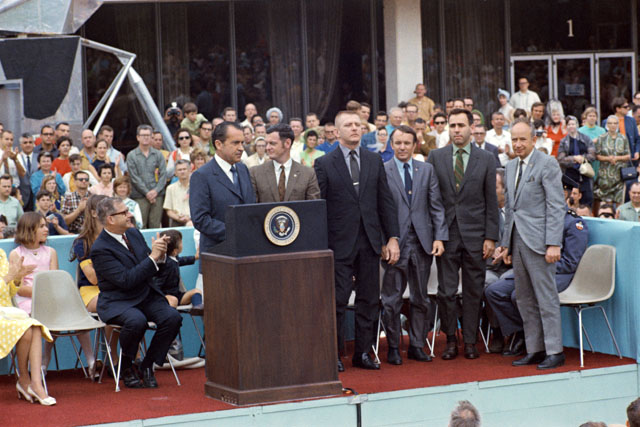
President Nixon at the Manned Spaceflight Center, Houston. On stage, Apollo 13 Flight Directors Glynn Lunney, Gene Kranz, Gerry Griffin and Milton Windler receive the Medal of Freedom along with Director Sigurd Sjoberg.
The next day, the President and the First Lady jetted aboard Air Force One to Houston. The President presented the Presidential Medal of Freedom, the highest civilian award of the United States, to the Mission Control and other support crew of Apollo 13. It was symbolically received by Sigurd Sjoberg, the Director of Flight Operations at MSC, representing the whole flight control team. The flight directors of Apollo 13 as well as the families of Jim Lovell, Fred Haise and Jack Swigert were present for the occasion. The anxious family members were taken on board the Air Force One for the trip to Hawaii to meet the newly rescued crew the same day.
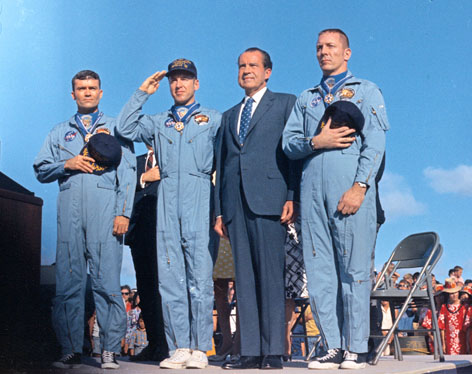
Richard Nixon poses with the crew of Apollo 13, having bestowed presidential honors on them.
With their newly arrived families in attendance, the President bestowed the Medal of Freedom to the Apollo 13 astronauts. The same award had been given to the crew of Apollo 11 the previous year. President Nixon declared the mission successful, despite its abortive nature. Presidential records show that the whole official part of the ceremony took only 22 minutes. Nixon spent the rest of the trip to Hawaii meeting military and political officials.
The crew visited the White House on June 9th, 1970, where the President and the First Lady hosted the crew and their wives for a private dinner. Besides the presidential couple and the crew, only 11 guests were invited. In September 1970, it was announced that the crew of Apollo 13 would undertake a goodwill tour as personal representatives of the President, just as the crews of Apollo 11 and 12 had done. Apollo 13 crew's tour lasted from October 1st to October 15th and consisted of visits to Iceland, Switzerland, Greece, Malta and Ireland. This was a tour considerably more modest in scope than that of the preceding crews.
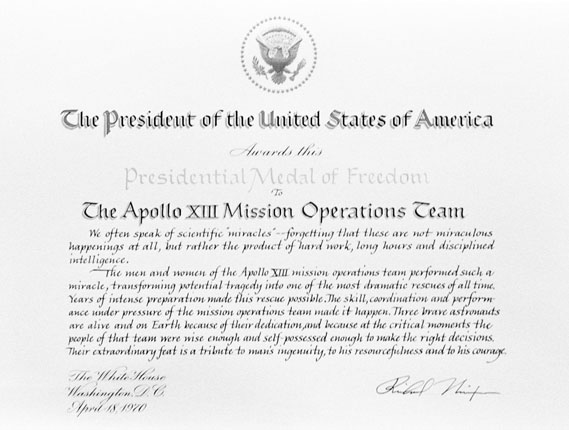
The Medal of Freedom article.
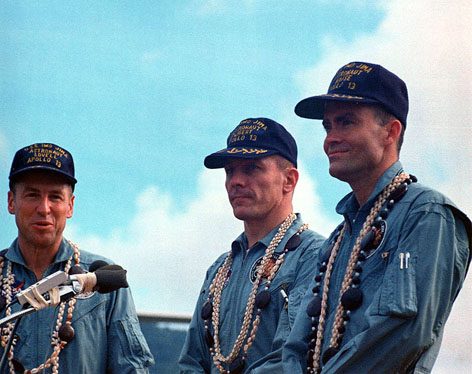
Lei'd crew of Apollo 13, feted by people in Hawaii.
Commission Investigation
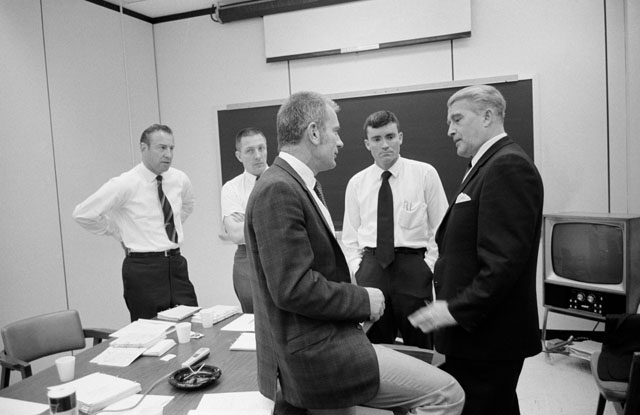
Lovell, Haise and Swigert during the Technical Crew Debriefing. Although Deke Slayton conducted the interviews, here they have been joined by Wernher von Braun.
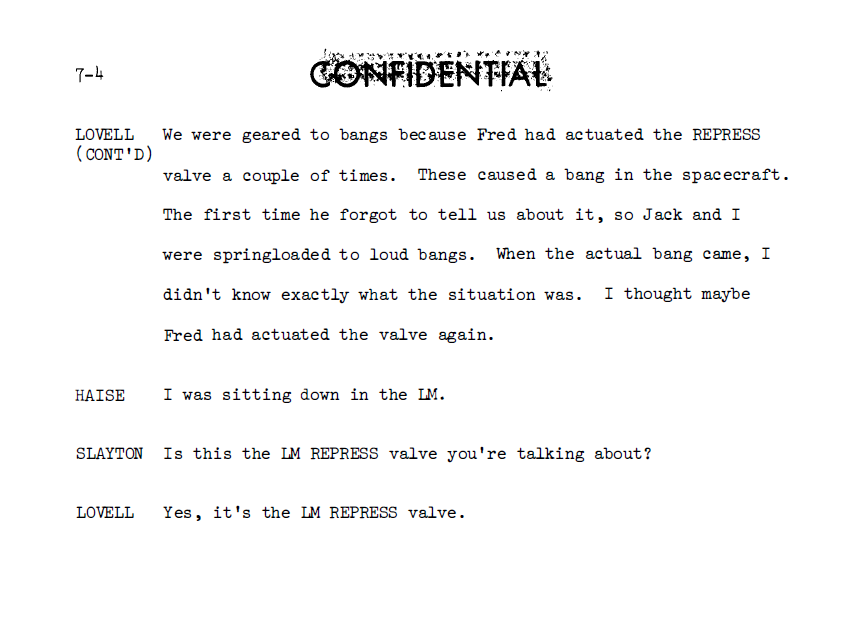
An example page from the technical crew debriefing transcript. The crew is discussing noises heard during the explosion here and mention the famous LM repress valve.
The normal mission debriefing took place soon after return to Houston. Known as the Technical Crew Debriefing, all aspects of the mission were covered. These interviews were conducted by Deke Slayton and were always held as soon as possible after the return, while the memories were still fresh. It was of particular importance now, to hear the crew's recollections of the accident.
It was already on the 17th of April that NASA Administrator Thomas O. Paine and Deputy Administrator George M. Low established an official commission to handle the investigation into the events of the mission. Officially known as the Apollo 13 Review Board, it was put under the responsibility of Edgar Cortright, the Director of NASA's Langley Research Center. Notable members included astronauts Neil Armstrong and William Anders, the latter already serving the US government as a specialist in spaceflight. The Board divided itself into four Panels, which would each investigate a different aspect of the mission and its event. In addition to this, NASA's Manned Spaceflight Center was conducting its own investigation under the command of Colonel James A. McDivitt. The Review Board operated until June 15th, when their report was presented.
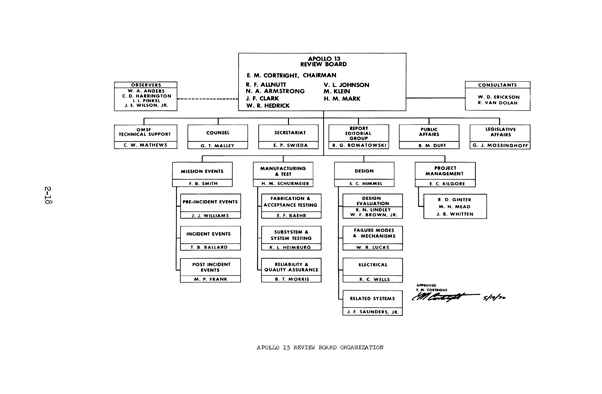
The complex organization of the Review Board.
The Board covered all aspects of the mission, from spacecraft component manufacture to launch operations, basic procedures, events during the accident, and the consequent attempts to rectify the damage and the danger posed to the crew. The actions of Mission Control received scrutiny, as did the land crews at ground support before the launch. Mission telemetry, voice recordings, transcripts, interviews and photographs from during the flight were investigated for details. Their special subject of interest was of course the oxygen tank that had apparently lost pressure during the event, and the associated paper trail that would tell them the history of this part of the spacecraft. A rather worrying picture emerged, which eventually helped the Board to come to the conclusions about the reasons behind the near-disaster of Apollo 13.
- • The accident was caused by the faulty O2 tank.
- • The design of the Apollo oxygen had inherent problems that could lead to malfunction.
- • Wrong practices during ground operations caused damage to the tank insulation, making it vulnerable to electric shorts and a fire within the tank.
- • Crew action could not have saved the oxygen system.
- • The tank design contained undue amounts of potentially flammable materials.
- • Personnel at many key organizations such as NASA and North American Rockwell were unaware of the potential issues with the tank.
- • Potential system incompatibilities between ground support equipment and spacecraft equipment were not all considered.
The Senate Hearing
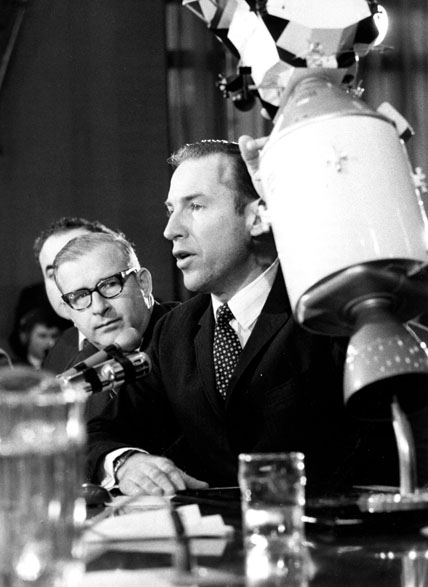
Jim Lovell at the Senate Committee hearing, with NASA Administrator Thomas O. Paine and Apollo Program Director Rocco Petrone.
Just a week after their return, Jim Lovell and Jack Swigert joined NASA officials at the US Senate for a session of the Committee on Aeronautical and Space Sciences. This April 24th hearing was convened to allow the politicians to hear the first-hand account of the accident and the expected disturbance to the Apollo program schedule. Besides the obvious topic of the incident, the crew and management people present had to answer some particular questions that had arisen. Jack Swigert had to defend himself against rumors about claiming that morale was low at the Kennedy Space Center, preparing for the launch, or that he had been doubtful over the mission's success. Similarly, Jim Lovell's remark on the air to ground radio loop about Apollo 13 being 'the last Moon mission for a long time' was scrutinized by the politicians. Lovell assured the Committee of his faith in the spacecraft and the program, and commented that his gloomy remark was due to the circumstances at the time onboard the Lunar Module, with no knowledge of what had exactly happened. What everyone agreed at least was that Apollo 13 had been a fantastic PR and international relations coup for the space program and the United States as a whole.
The Explosive History of O2 Tank 2
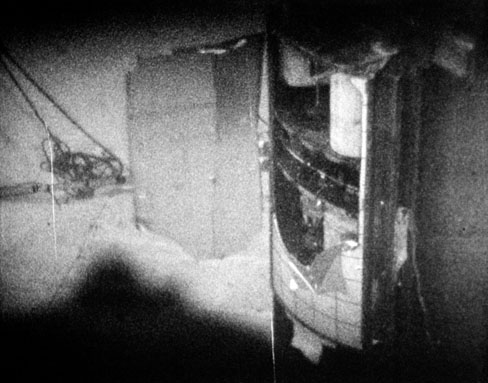
Slow motion photography shows the separation of the simulated Service Module panel due to tank explosion.
As with most manmade disasters, the emergency onboard Apollo 13 was not a single strike of extraordinarily bad luck but rather a series of events that came together in a perfect storm of conditions that led to the destruction of the oxygen tank onboard the spacecraft. These events began to unfold a whole four years before Apollo 13 flew.
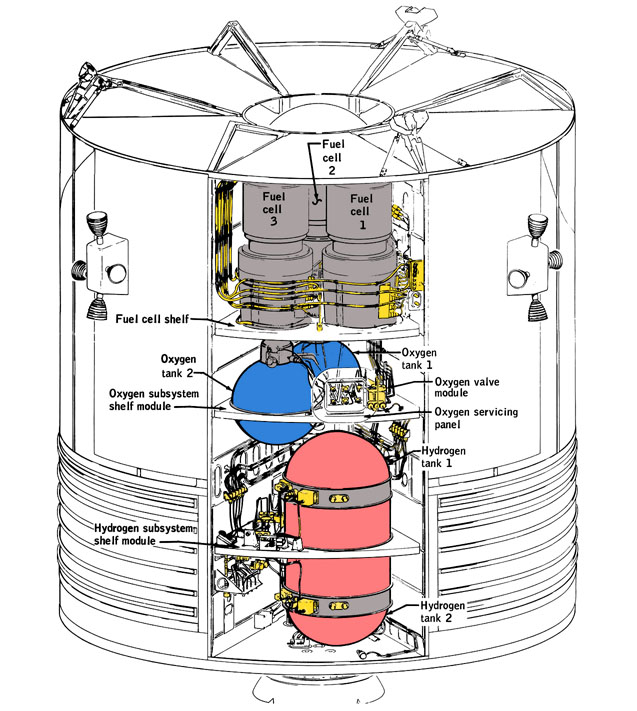
The arrangement of Sector 4 in the Apollo Service Module.
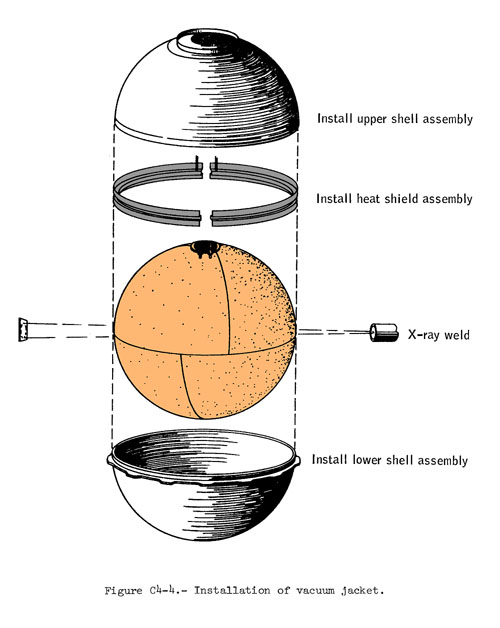
The Apollo tank was a Dewar type vacuum bottle where the vacuum served as the primary insulation between the twin walls of the tank. Extremely high pressure and low temperature turned the oxygen into a supercritical fluid, neither liquid nor gaseous under the cryogenic conditions.
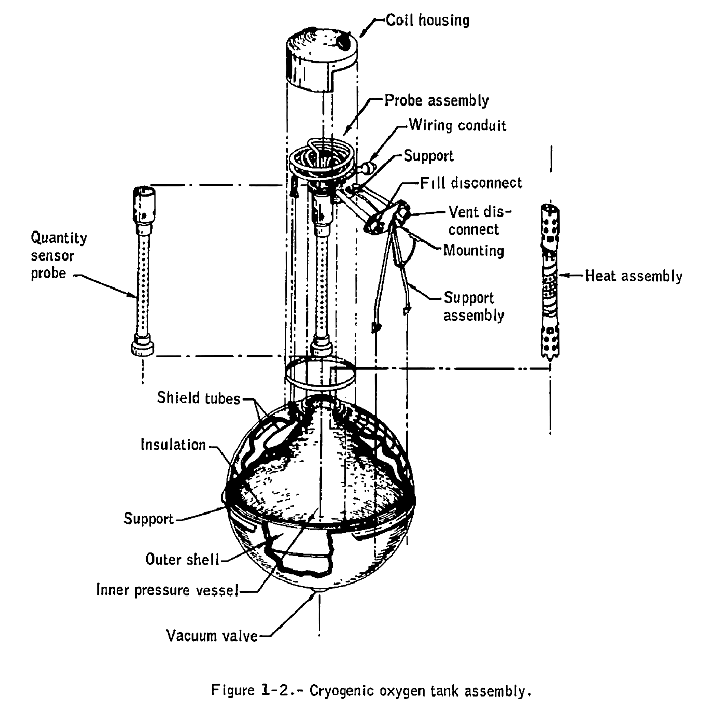
Components of the O2 tank.
The life of an Apollo oxygen tank was an eventful one even before heading for lunar orbit. The tanks were produced by Beech Aircraft Corporation (now part of Textron Aviation) working as the primary contractor for the Apollo Command Service Module builder, North American Rockwell (now part of Boeing). The cryogenic storage unit eventually dubbed as Tank 2 or ‘100024XTA008’ was initially forged in April 1966 by Cameron Iron Works in Houston, Texas. They procured the two hemispheres of Inconel 718 nickel-chromium alloy, processed into their rough original shapes. From Houston the two halves of the tank were shipped to The Airite Division of the Electrodata Corporation in Los Angeles for further work to refine their shape and structure. It was also there that the welding together of the two halves of the tank took place to create the spherical pressure vessel. At this point the tank was shipped to Beech Aircraft Corporation's plant in Boulder, Colorado for final assembly under clean room conditions. First a layer of insulation was placed around the pressure vessel, consisting of fiberglass and aluminized plastic sheets. On top of this, the outer shell, forged out of Inconel 750 nickel-chromium alloy, was welded. A plug made of Inconel alloy served as the installation point for the internal equipment of the tank.
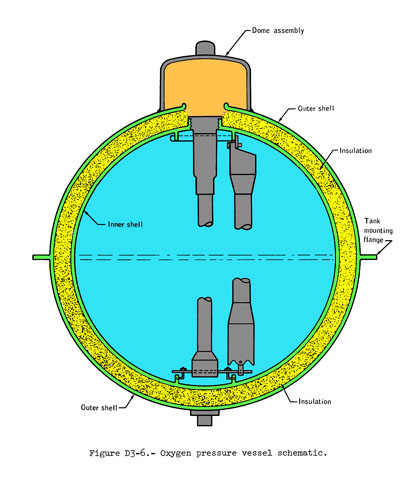
The oxygen tank was a double-skinned, vacuum-insulated pressure vessel that also contained a wide range of electric equipment.
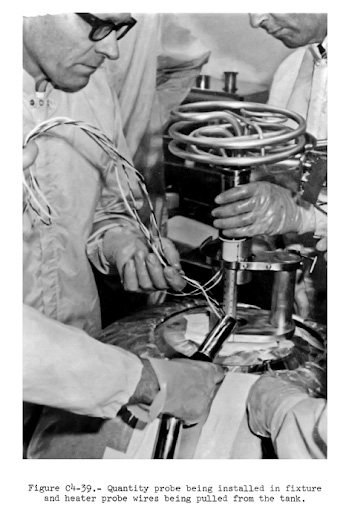
Manual assembly of the internal electric components of the tank.
The assembly of the tank was performed by hand at the Beech factory. A twin electric fan, an electric heater, and electronic temperature and quantity measurement gauges were inserted into the tank via an opening on the top of the tank, known as its neck. Many lengths of electric wiring accompanied the electrical equipment into the tank along with the piping needed to transfer oxygen in and out of the tank. All these components exited the tank at the top.
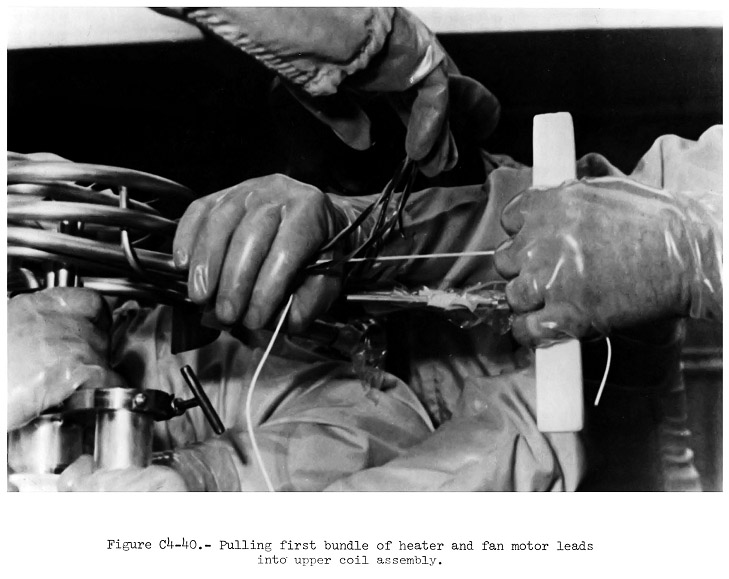
Pulling electric wires from within the tank and out for installation.
Considering the shape and structure of the tank, the electric elements installed within could not be properly inspected visually for damage. All the internal components were inserted through an opening at the top, which also required the engineers to use long bundles of cabling that could easily be snagged onto sharp corners and surfaces within the installation. With the assembly of the interior components being made to a great degree in the blind, it was impossible to tell whether everything was in order, beyond looking at any possible faulty electronic signals produced by the equipment. The structure was investigated by X-raying, but would not offer conclusive results, as was later revealed when it became necessary to perform such checks on various tanks, including those destined to be onboard Apollo 13. The resolution was either not sufficient, or the desired components were transparent in X-rays and could not be visualized.
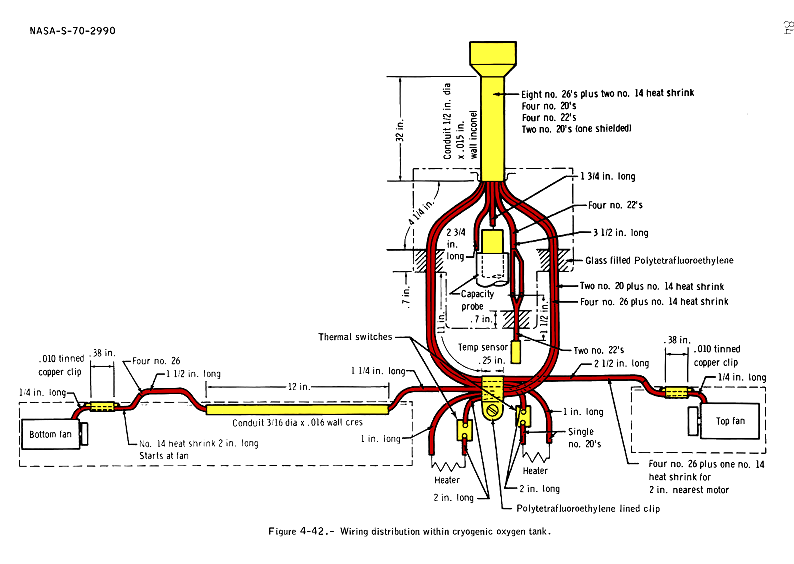
Arrangement of the wiring inside the O2 tank. The Teflon insulation around these cables provided the fire with fuel.
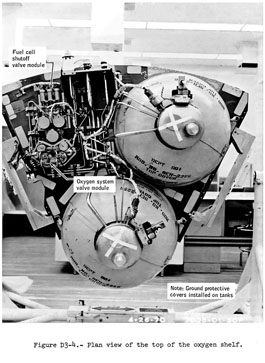
The whole oxygen shelf awaiting installation into Service Module. It contained the two oxygen tanks and the associated valve and control modules.
As the Apollo program proceeded, so did spacecraft assembly at the North American-Rockwell factory in Downey, California. Tank ‘0008’ was originally destined to be installed onboard Service Module 106, which was to be part of the Apollo 10 stack. Two oxygen tanks and associated electronics, piping and valve modules were installed onto an aluminum honeycomb shelf that would support them inside the Service Module. The integration of the shelf into the spacecraft happened on 4 June 1968. Everything tested out perfectly fine at this point and there are no records of any problems beyond small issues that were found from most production units and which were easily rectified. In August 1968, an order was given to replace some of the tank components in order to prevent electronic interference between the tank equipment and the rest of the onboard electrical equipment. This work was undertaken on spacecraft 106 on the 21 October 1968 at North American Rockwell's assembly plant. To remove the oxygen shelf and the tanks, screws holding it in place were opened. Due to a mistake in procedure, only 10 out of the 11 screws were open when an attempt was made to remove the shelf. This resulted in the shelf pivoting upwards and then falling back onto its place, a distance of a mere two inches or five centimeters. The upwards motion caused the top of O2 Tank 2 to collide with the aluminum fuel cell shelf above before the tank shelf fell down to its original position.
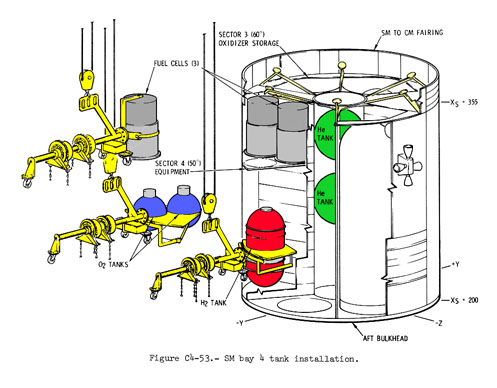
Installation of the equipment into the Service Module, including the hoist and counterweight machinery used to remove the oxygen shelf from Bay 4.
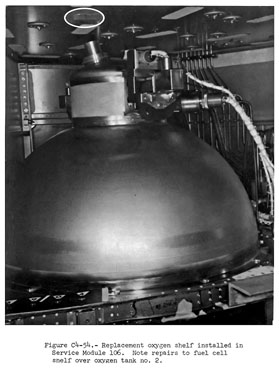
Repaired damage on the fuel cell shelf onboard Apollo 10's Service Module.
An investigation was immediately started into the tank handling accident at the factory. The oxygen shelf was succesfully removed and underwent testing to ensure that the tanks had not been damaged. Minor repairs were also required on Service Module 106. With the flight of the spacecraft approaching, it was decided to swap in a completely new oxygen tank shelf. Service Module 106 would later fly to the Moon as the Service Module on Apollo 10 in May 1969 - without tank '0008'. Whether Apollo 10 might have suffered a similar fate to Apollo 13 due to the dodgy tank remains unknown.
The consequences of what is usually known as the tank drop incident remain somewhat unclear, and are a continuous source of speculation. The oxygen shelf and its two oxygen tanks, particularly '0008' which had collided with the shelf above, were refitted with the new components as per the original plan. The shelf was installed onto Service Module 109 on 22 November 1968, which would then become part of the spacecraft slated to fly the third lunar landing mission, Apollo 13. The tank drop incident remains a popular explanation to why tank '0008' developed problems later, but this is not something that should be taken without consideration. The tank drop incident was extensively reinvestigated after Apollo 13, and this included mathematical modeling of the potential forces the tank was subjected to. Albeit considerable forces were generated, it is unknown whether these were sufficient to cause true internal damage. Every Apollo component, the Service Module and its tanks included, had to survive the vibration, acceleration and the acoustic forces of a Saturn V launch as well as various accelerations and decelerations in several directions, even during a nominal mission profile. Tank 2 had fulfilled these criteria without problems. Although it is possible that the tank drop jarred the internal components and provided one step on the long list of unfortunate events that led to the accident, we cannot be certain that this was the case. Any correspondence between the tank drop and the accident may also be incidental, especially when considering what happened to the tank after the spacecraft left the factory.

O2 Tank 2, installed aboard the Service Module that would fly as Apollo 13. Below is the top of the hydrogen tank. Above is the shelf containing the three fuel cells. All surfaces are covered in Kapton foil insulation.
The spacecraft that would be flown as Apollo 13 was delivered to Kennedy Space Center in Florida some nine and a half months before the launch. There, all systems were repeatedly tested during preparations leading to the launch. Major events pertinent to the cryo system included a swap-out of the previously installed fuel cells, as well as the removal of one of the hydrogen tanks to replace a faulty unit onboard Apollo 12. Although this involved manipulation of the part of the Service Module that contained the oxygen tanks, nothing unusual is known to have happened at this time, especially in regards to the potential for damage to the oxygen system.
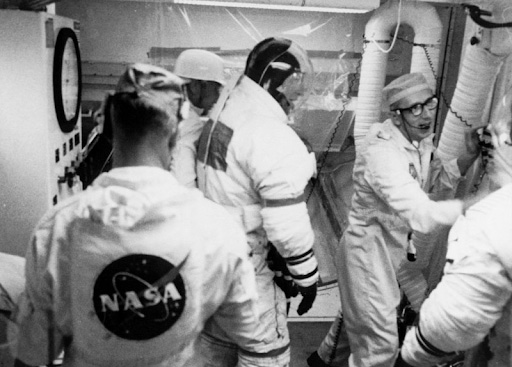
The crew of Apollo 13 boards the Command Module for the Countdown Demonstration Test, assisted by Pad Leader Guenter Wendt.
The first signs of trouble were spotted during the Countdown Demonstration Test (CDDT). This was considered a dress rehearsal for the actual launch up until the point of engine ignition, and involved the crew onboard the spacecraft and the various tanks filled both on the spacecraft and the Saturn V booster. On 23 March 1970, as part of the test, an attempt was made to drain the two O2 tanks to approximately 50 per cent quantity. While tank number 1 emptied normally in a few minutes by forcing gaseous oxygen into the tank from the ground servicing equipment, tank 2's contents only decreased by a few per cent. This is the first known operational issue with tank 2.
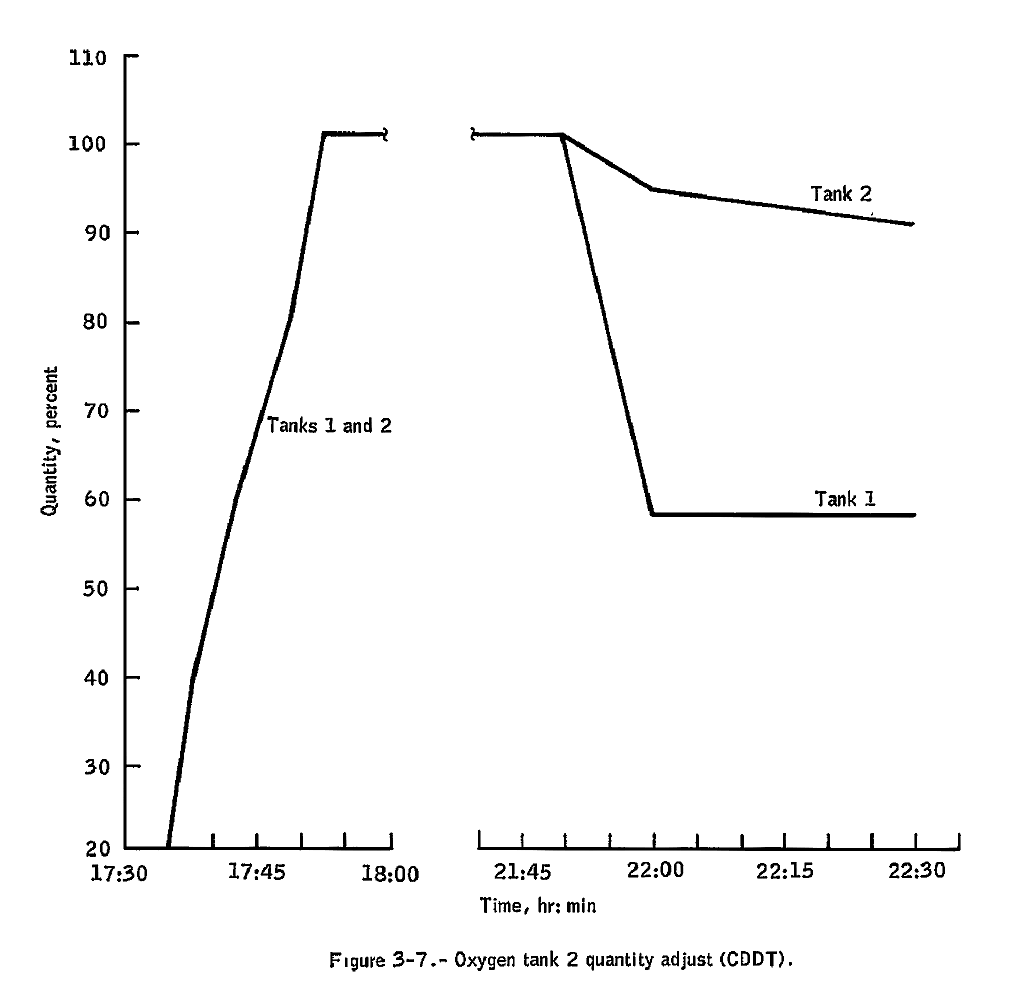
This graph shows that while tank 1 emptied rapidly, tank 2's contents only dropped minutely.
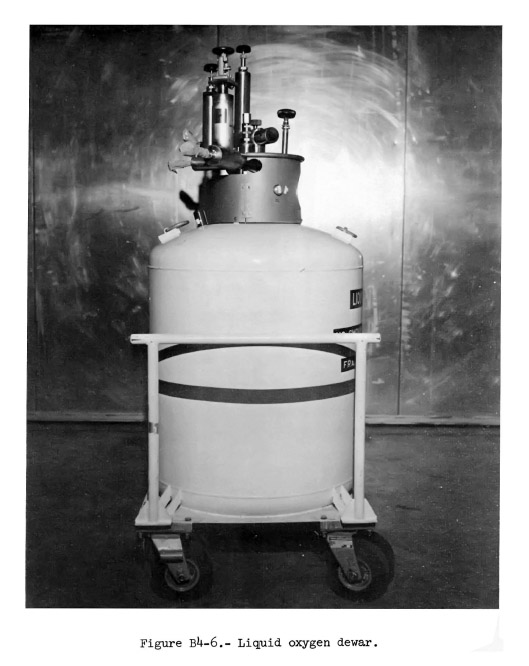
Giant thermos used for transporting liquid oxygen to the launch service tower.
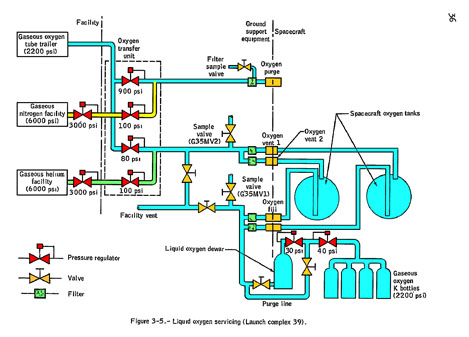
Arrangement of the oxygen servicing system.
A rapid troubleshooting effort began. The first suspect was the ground support equipment used to pump the oxygen into the tank. Yet it was soon determined that no fault existed in the equipment, particularly the oxygen filter they suspected could have become clogged and hence prevent the normal flow. The engineers turned their attention to tank 2 itself.
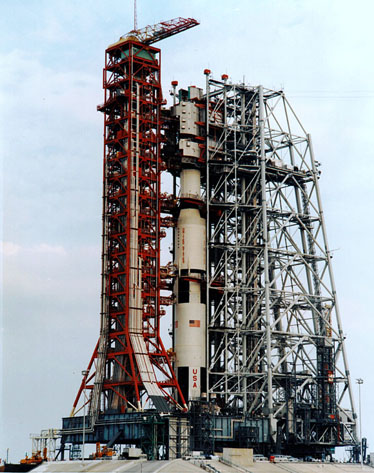
Apollo 13's Saturn V stack standing on the launch pad, with the Mobile Service Structure in place.
Investigating the tank while the spacecraft was on the launch pad would not be easy. The Mobile Service Structure used to protect and permit access to the vehicle while on the pad could not accommodate the equipment needed for checkout and possible replacement of the oxygen shelf. It might be required to roll the entire Saturn V stack back to the Vehicle Assembly Building.
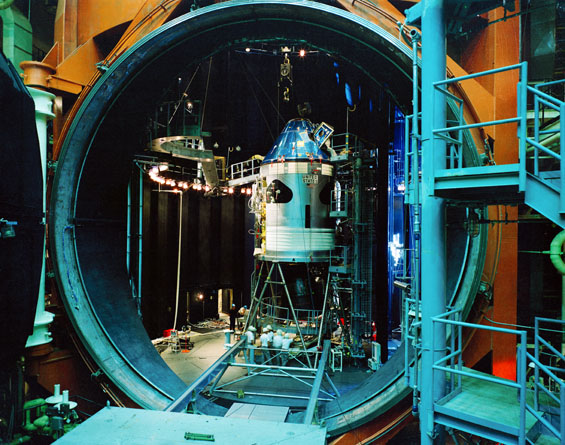
Apollo test vehicle TV-1. The complete Command Service Module sat on a test stand inside the Space Environment Simulator (SESL) at Manned Spacecraft Center.
Engineers at the Manned Spacecraft Center in Houston suggested that something that could help with the Apollo 13 tank investigation involved looking at the oxygen tanks that had been installed onboard ATV-1. This prototype Apollo Command Service Module was located in the thermal vacuum test chamber in Houston where the entire vehicle could be operated under simulated space conditions of extreme heat, cold and vacuum. Engineers recalled that the ATV-1 vehicle had experienced detanking problems as well. The decision was made to investigate the ATV-1 tanks to get clues for the present Apollo 13 issue. The tanks were to be disassembled and X-rayed in Houston. Work on this continued over the weekend, which coincided with Easter in 1970.
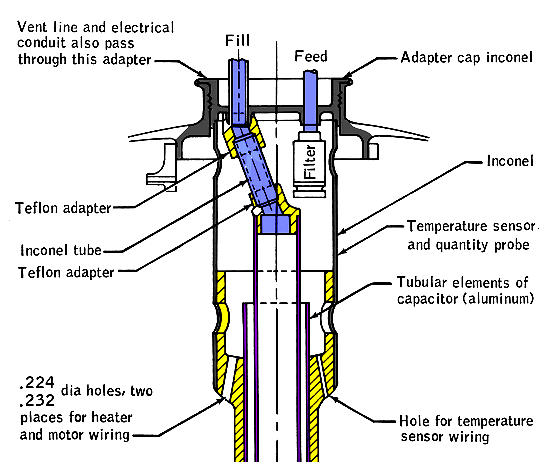
Structure at the top of the oxygen tank. An Inconel cap welded into place over the opening on the top of the tank contained passages for the oxygen tubing and cabling into the tank. The fill line was not only used to fill the tank but also to empty it while on the launch pad.
The main suspect for the detanking failure was a portion of the tube that was used to both fill and empty the oxygen tank. As it passed through the top of the tank, a portion of it was bent before the tube continued downwards towards the bottom of the tank at its center. This part of the tube was known as the 'dog's leg'. It was known that due to the manufacturing tolerances in the construction process, the fit of the various parts of this portion of the tube might not be particularly tight. A calculation suggested that there could be as much open space there as the open area of the tube itself, which meant that an attempt to push the liquid oxygen out of the tank would lead to the liquid oxygen being forced back into the tank from the gaps in the tube fitting. Investigation of the ATV-1 tanks supported the theory. There was an additional worry that the loose fitting of the fill tube could cause the temperature probe inside the tank to short out, but the energy generated by such an incident would not be enough to cause dangerous electric arcing inside the tank. This satisfied the engineers and the Apollo management. The fill tube issue was likely benign, they thought, and the ATV-1 tank evidence supported their decision. At no point was the previous tank drop incident discussed, or taken into account while considering the safety of the tank. Nobody in the management or the engineering team appeared to have had knowledge about this past insult against the tank. The Investigation Board did consider it was possible that the tank drop, while not enough to cause major damage, could have been enough to jar an already ill-fitting pipe segment into an even worse position, which could lead to the inability to drain the tank and the subsequent destructive attempts to do so. It is also not known how the engineers or the management would have reacted to the fill pipe theory if they had known about the previous incident with the tank. What we know is that the incomplete information led to the Apollo management acting as they did.
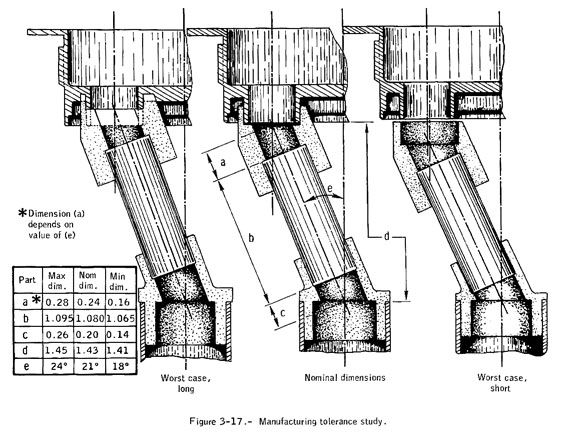
Diagram showing potential configurations of the fill tube, also known as the "dog's leg".
By the 27th of March, a new plan was developed and then put to action. If increased flow pressure of gaseous oxygen would not empty tank 2, they would turn on the internal tank heaters and attempt to empty the tank by boiling off the liquid oxygen into gas. The plan was contemplated and the available documentation checked to find out whether the prolonged heater operation could cause problems. None of the paperwork suggested that it might be dangerous for any reason, as long as the pressure inside the tank remained within specifications. It was a Friday night when the heaters were finally switched on and operated for at least eight hours, with engineers monitoring the process of the detanking at their consoles. Much to their delight, the oxygen quantity in tank 2 began to decrease.
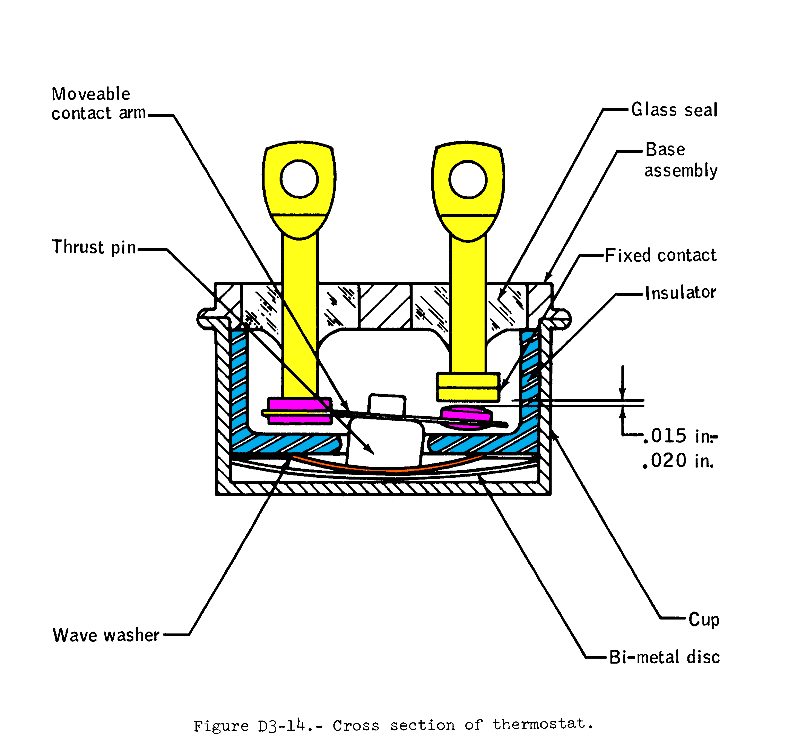
Schematic diagram of the thermostat breaker.
What the engineering crew failed to appreciate was that extremely dangerous conditions had developed. The heaters inside the Apollo oxygen tank were designed to operate in flight using 28-volt direct current power generated by the fuel cells. However, at Kennedy Space Center, the ground support equipment utilized 65-volt DC power. The higher voltage was applied to provide more power and pressurize the tanks more rapidly in the preparation for spaceflight. The heater circuit was protected by two thermostatic switches. They were rated to open when the internal temperature reached 80°F. In the transition from Block I to Block II configuration during the Apollo development process, there was no review of the thermostatic switch and its operation with the 65-volt power output from the ground service equipment. A four-way failure in communications between the tank subcontractor (Beech Aircraft), the spacecraft vendor (North American Rockwell), Manned Spacecraft Center (Houston) and Kennedy Space Center (Florida) had led to nobody being aware of this fault in the system. With the paper trail broken, nobody was in a position to express concern about the excessive voltage posing a threat.
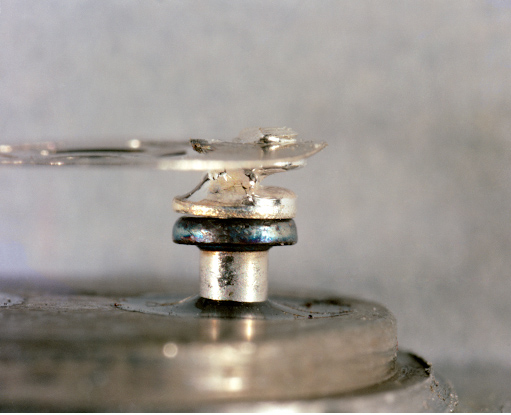
Laboratory testing reproduced the thermostat meltdown under the excess current.
Post-flight testing of flight equivalent hardware proved that although the thermostatic switch could support current delivered at 65 Volts when the circuit operated normally, an attempt by the switch to open due to its own specific purpose, protection from overheat, would cause breaker to fuse itself shut due to the excess current. This is presumed to have happened on the night of 27 and 28 March with the tank heaters operating inside Tank 2. With the overheat protection removed from the system, the heaters continued to operate much longer than was safe. The prolonged operation caused the internal temperature to rise to 1,000°F (over 500°C). This was enough to damage the Teflon insulation of the wiring inside the tank, immersed in the liquid oxygen.
Ought not the ground crew to have still been able to notice something amiss with the O2 tank? Was there no way for them to determine that the interior of the tank had reached scorching, insulation-melting temperatures? The answer lies in another limitation of the instrumentation at use. The readout at the tank temperature gauge was capped at 84°F, meaning that if the internal temperature went higher than that, the indicator remained at that temperature and did not suggest that the tank interior could in fact be much hotter.
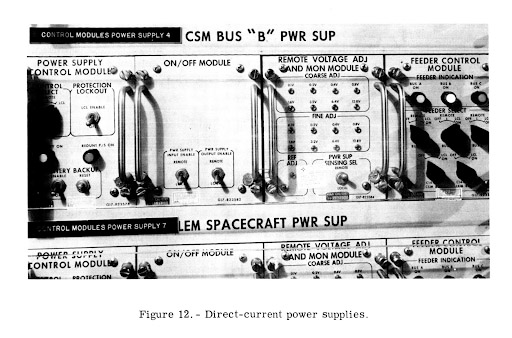
Ground Support Equipment panel used to supply electric power to the spacecraft.
Although tank 2 had now been emptied, consternation remained on the exact condition of the problematic fill tube. Two issues were still considered; if the kinked fill line could prevent a successful loading of the tank, and if the loose fit of the fill tube could cause an electric short within the tank. It was decided to fill the tank on March 30 to see whether it could be loaded without issues. This would be a deciding factor on whether tank 2 could be considered ready for launch, or if the equipment should be replaced. This would require two days and the deassembly of the Service Module, which not only would push the schedule but also exposed the Service Module to other problems. Any extensive work inside would risk the ground crew accidentally damaging other equipment while manipulating the oxygen shelf, which would then lead into new problems.
The test was successful, but once again tank 2 failed to empty normally and the extended heater operation was repeated, most likely with similar results to the first detanking attempt using the boil-off method. Even this did not finally alert the management to swap out the tank. The fill tube was not a piece of equipment required during the actual mission, since the oxygen from the tank flowed into the onboard systems using another pipe, which functioned perfectly. As long as the tank could be filled, the tank was seen as good to go. With the tank now proven operational in the eyes of the management and with everyone oblivious to the potential danger it posed, it was decided to go ahead and launch the spacecraft with tank '0008' installed.
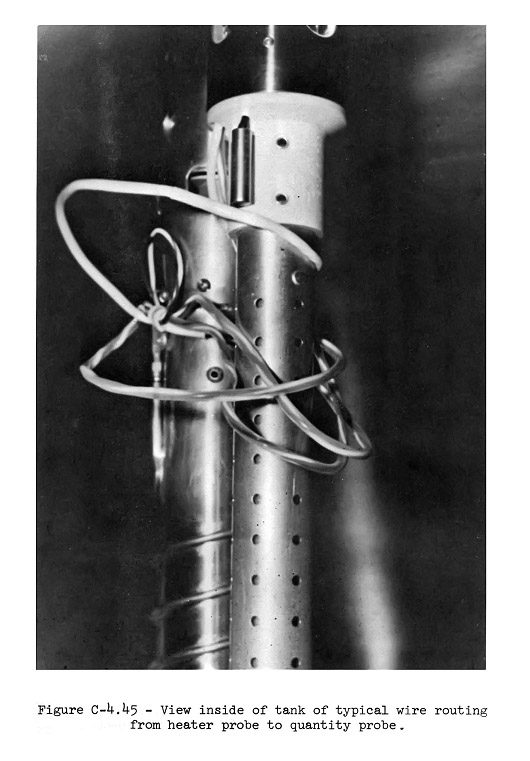
Internal wiring of the O2 tank.
With the commitment to launch made, Apollo 13 would go to space with a severely damaged oxygen tank. Although the exact condition of the interior of the tank remains unknown, based on the events and the subsequent testing, it is extrapolated that the heat-damaged Teflon insulation on the tank wiring finally gave out during the repeated stirrings that were part of the normal operational procedure while in space.
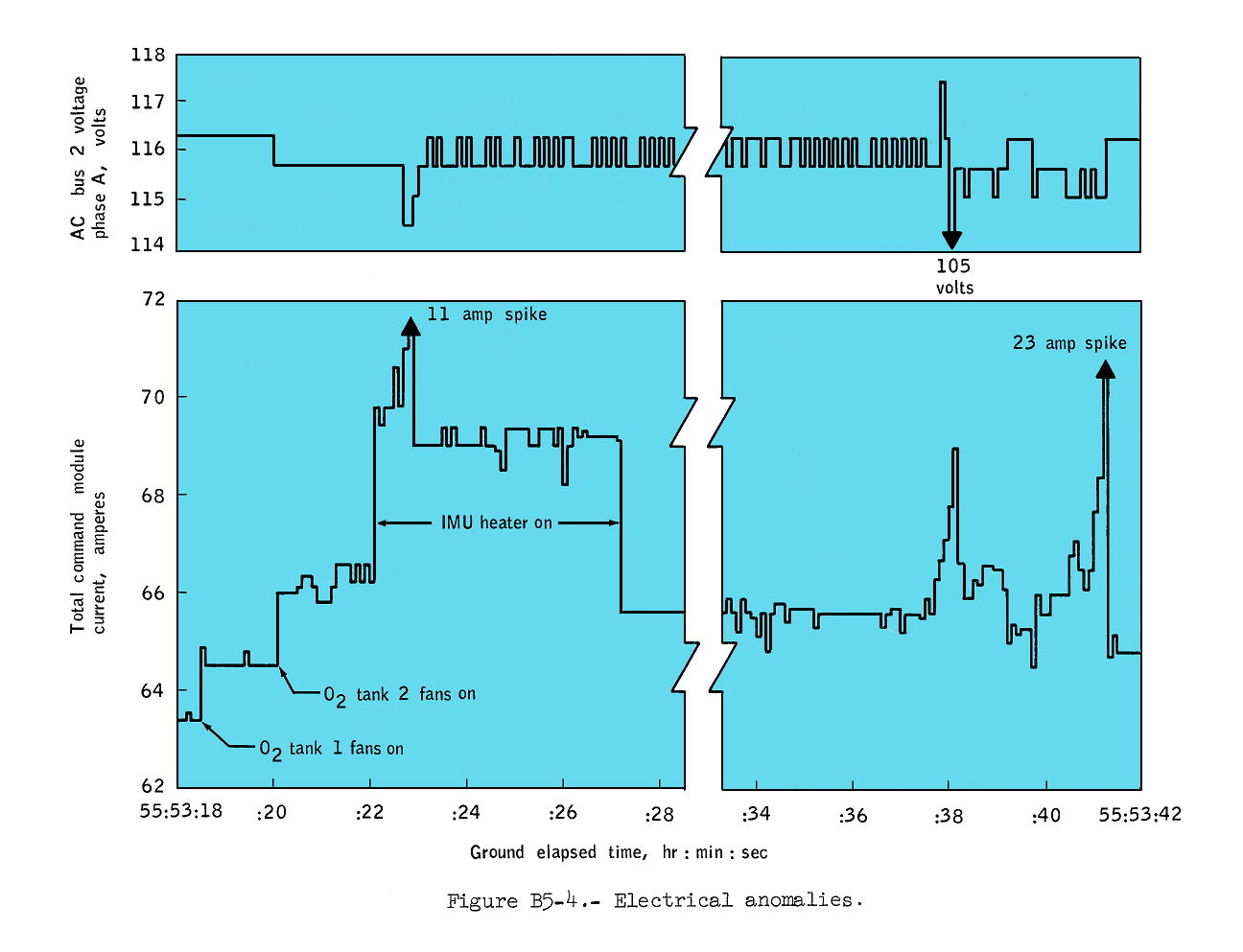
Telemetry shows two power spikes in the Electric Power System, moments before the accident. These probably indicate the O2 tank 2 fan motors shorting out and lighting the fire.
The triad of conditions required by the explosion were present in the tank at 055:53:20 GET when telemetry indicated the fans were turned on. The supercritical oxygen provided the oxidant, the Teflon insulation the fuel, and the damaged wiring the spark that would start the fire. As the two fans shorted out, the electric arcing began the fire. The continued combustion caused the interior pressure to start to rise. Although by this point nothing could have been done to stop the fire, neither the crew nor the flight controllers were made aware of the growing pressure inside the tank. The caution and warning system was designed in such a manner that only one abnormal condition in the cryogenic system could be displayed at any given time as a CRYO PRESS warning on the display console. At the time, such a condition already existed due to the benign pressure issues in one of the hydrogen tanks. Hence no warning about the rising O2 pressure could come through.
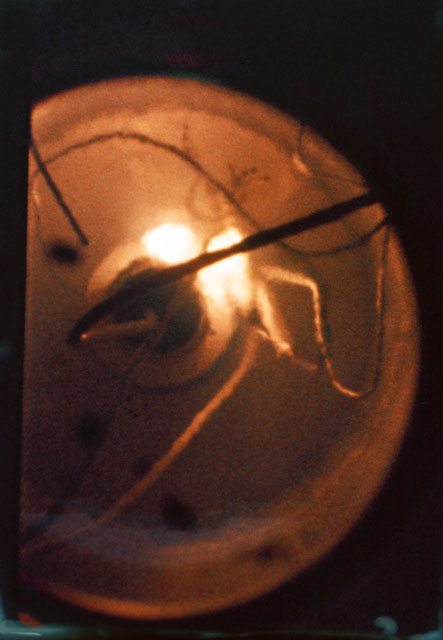
Insulation and wiring burns in 100-per-cent oxygen during an engineering test to simulate the tank conditions.
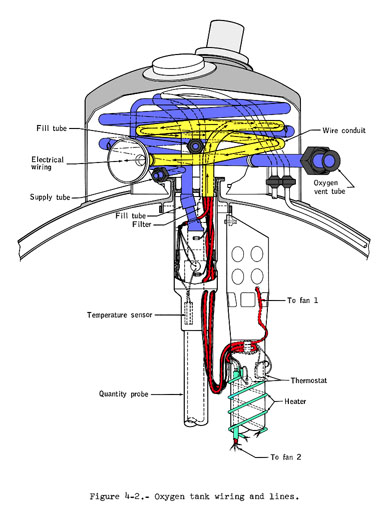
A diagram of the top of the oxygen tank assembly. It is likely the fire started on the wire bundles located here, and moved towards the top of the tank.
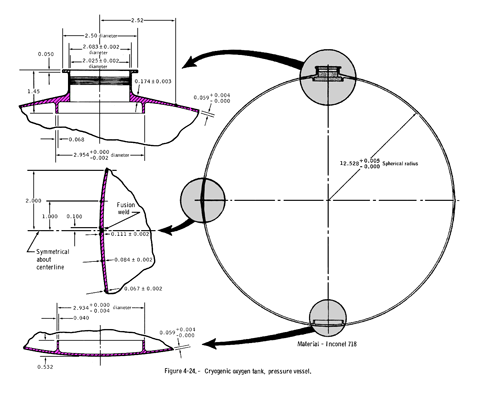
Structures and locations of the seams and welds in the O2 tank. The most likely location for failure was at the top where the electric conduit entered the tank.
The fire moved slowly along the probe assembly inside the tank, burning the Teflon insulation on the tank wiring. The increasing temperature caused the pressure inside to start rising, which it continued for perhaps 90 seconds or two minutes. A brief drop was detected in the telemetry, which indicates that a relief valve installed into the oxygen line opened as per its specifications, to attempt to lower the tank pressure by releasing some oxygen into space. The fire most likely propagated towards the top of the tank, which is also where the weakest point of the tank was located at the penetration of the quantity gauge into the tank. The pressure reached a little over 1,000 psia - half of the rated maximum burst pressure - which finally broke the tank near the top. A protective dome covered the top of the tank with a burst disc designed to open at 75 psia. Most likely this protective feature activated as well when the tank contents rushed into the dome, which released high pressure hot gas into Sector IV of the Service Module. Thermal sensor telemetry suggests that the Mylar/Kapton insulation wrapped everywhere inside the Service Module were scorched by the release of hot gas before the entire contents of the O2 tank 2 were finally released into the Service Module with explosive force. The bang and a jolt detected by the crew was likely either the tank breaking, or the hull panel tearing off.
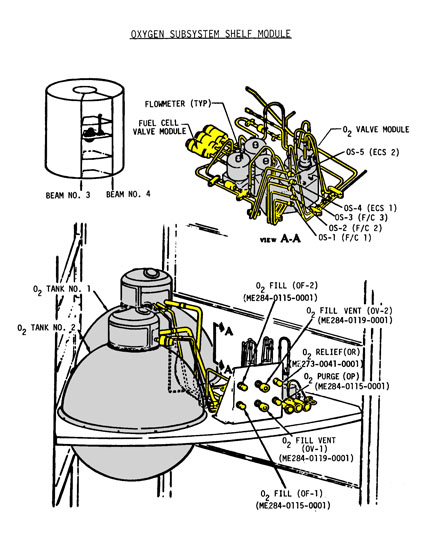
The whole installation of the oxygen shelf and the the O2 valve unit.
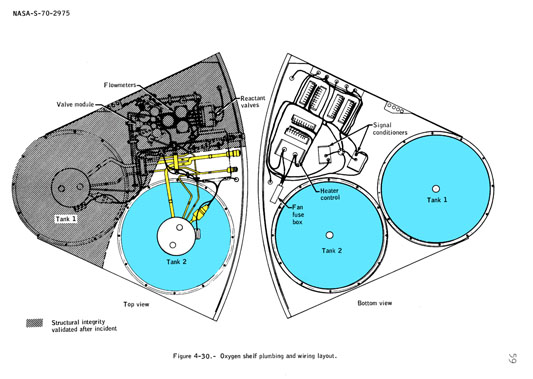
Layout of the tank shelf. The marked area could be verified to be intact from the post-accident photographs obtained by the crew of Apollo 13.
As the explosion destroyed tank 2, the released gas caused the exterior panel of the Service Module to separate almost cleanly off the spacecraft with only a small corner of it remaining on its fittings. Along the way it struck the High Gain Antenna and caused a drop in communications. The resulting shock wave or the debris from the destroyed tank caused enough damage to tank 1 and the adjoining equipment that it too would slowly lose pressure. Although the oxygen tank system was redundant, with its double tanks and their own individual piping, their immediate proximity to one another on the close confines of the oxygen shelf meant that such a destructive event on one tank could easily cause such damage. Approximately 25 psia of uniform pressure on the hull panel was required to break it loose. Had the panel not failed and were the force of the explosion directed upwards towards the Command Module, a pressure of only 10 psia would have been required to break the Command Module away from the Service Module.
Corrective Actions Taken
Once the causes of the Apollo 13 accident became apparent, it was possible to begin to plan for the future. A multitude of changes were to be made to the spacecraft itself as well as ground equipment and procedures to ensure that a similar accident could not happen again. A great number of improvements were carried out, not only to improve general system redundancy and safety, but also to ensure the crew's survival in case of a serious malfunction.
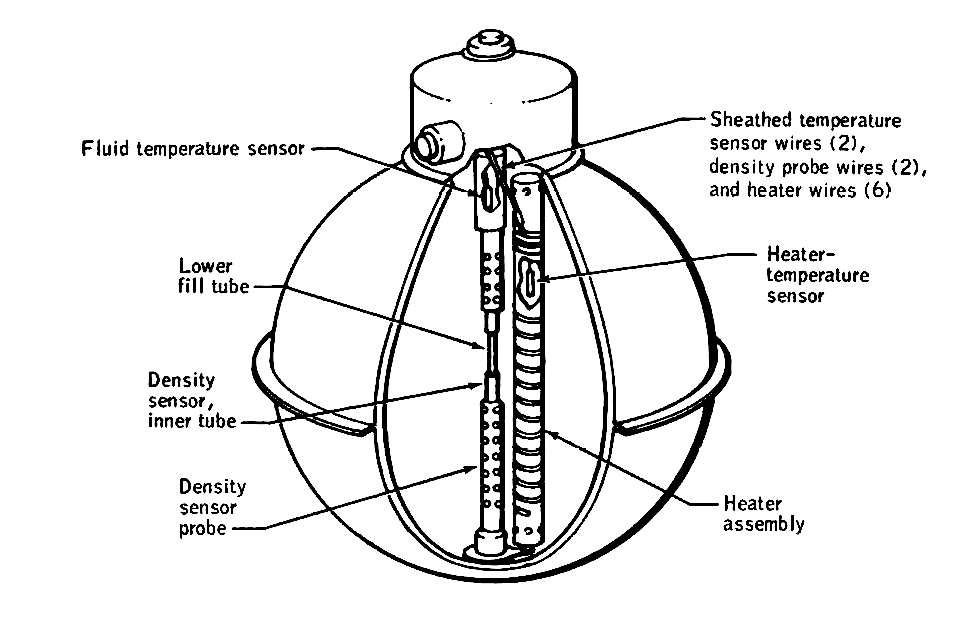
Improved cryogenic oxygen tank for Apollo 14 and subsequent missions.
Considering that the cryo tank for storing liquid oxygen was the cause of the accident, it comes as no surprise that a major change in design had to be enacted to ensure the safety of the oxygen tank system for future missions. The primary concern was to remove any flammable materials from inside the tank. Teflon insulation was removed and replaced with magnesium oxide. All wiring which had previously been free inside the tank was sheathed in stainless steel for extra protection. The heaters were redesigned to have three elements instead of two, and separate control of each element was provided for more careful control of the heating levels. The heater would become the sole system responsible for managing the internal pressure, since the oxygen tank cryo fans were removed altogether. The thermal switches that had allowed the onboard temperature to rise to catastrophic levels were also removed. The quantity gauge probe and the oxygen filter received redesigns as well.
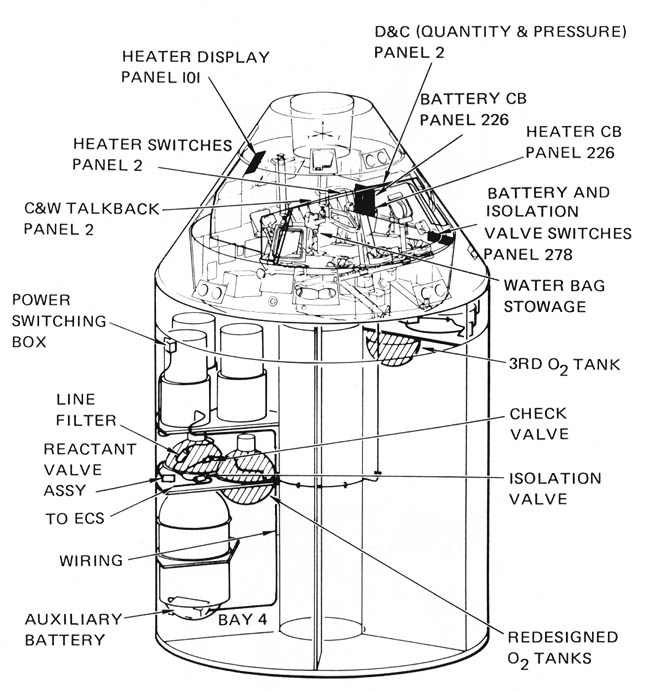
Diagram showing the CSM improvements and alterations after Apollo 13.
A great number of other changes were made, beyond the replacement of the tank assembly. The fuel cell valves were redesigned for extra safety, with additional instrumentation added. A major new component was the inclusion of a 400 amp-hour battery in the Service Module of a design used in the LM Descent Stage, to act as an emergency power source during contingency situations. This would give the onboard crew and Mission Control extra time to troubleshoot any problems. It was even determined that the spacecraft could make a low power emergency return from lunar orbit simply using the new auxiliary battery.
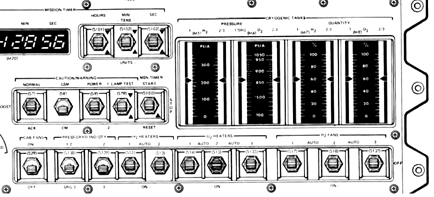
New controls in the MDC, with facilities for monitoring the new O2 tank. Fan switches have been removed.
Although inadequacies in the caution and warning and display systems were not directly causative of the accident, several changes were made to better inform the crew of any discrepancies that might be threatening the safe operation of the spacecraft. This included changing the alert limits for low or high pressure situations, as well as changing the valve indicators to display the status of O2 and H2 valves independently. The newly installed equipment received its own indicators and instrumentation as well, requiring changes to the displays in the Command Module.
The dehydration and subsequent discomfort and illness experienced by the Apollo 13 crew was not forgotten either. It was decided to carry five 1-gallon water bags in the Command Module, so that should the water system onboard fail, the contents in the potable water tank could be transferred into bags and kept inside the cabin. This would prevent the situation that developed onboard Odyssey when the drinking water supply froze and prevented the crew from getting water out of the still considerably full tank. Perhaps keeping in mind their similar issue with storing urine, it was noted that that the containers could also serve that purpose.
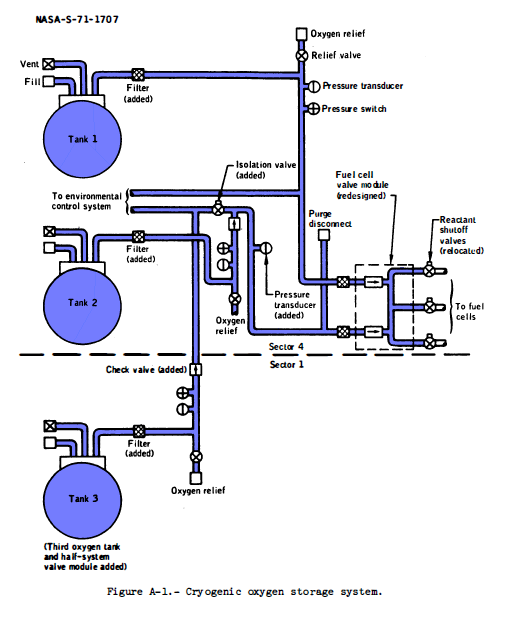
Diagram of the refit oxygen system for Apollo 14 and subsequent missions.
A redesign of the whole O2 storage and utilization system followed. A third cryogenic oxygen tank was added into sector 1 of the Service Module, opposite sector 4 which contained the power generating equipment and the rest of the oxygen tanks. Piping allowed the new tank to either supply the primary fuel cell and cabin oxygen system, or it could be isolated and used to provide the crew with breathable O2 in case the primary supply was lost. Should the tank be isolated, however, it would not be able to supply the fuel cells for power generation.
The equipment installed and refined as a result of the Apollo 13 accident not only improved safety, but they also helped in reaching even greater scientific results during the subsequent missions. The addition of a new oxygen tank was later augmented with a third hydrogen tank, to prolong the fuel cell operational time. This allowed for the longer J type missions with orbital scientific instrumentation carried on the Service Module, and the Lunar Roving Vehicle on the Lunar Module to extend the range of surface operations. The Environmental Control System in the Command Module was modified to accommodate a standard EVA capability that was required for retrieving film cartridges from the Service Module Scientific Instrument Module Bay. Hence, even without the modifications resulting from Apollo 13, the Apollo spacecraft would have nonetheless continued to evolve for the range of missions requested of it.
Immediate changes to the Lunar Module were fewer. The longer 3-day missions required a larger capacity for storing oxygen, water and electric power, and all these could be used for supporting the crew in an emergency as well. New procedures were planned and included in the checklist procedures carried for the missions to give the crew a ready access to emergency operational instructions, such as setting up the LM as a lifeboat. Many of the procedures included were those that had already been used during the flight of Apollo 13 and proven useful. This included a diagram showing the arrangement of the tape and plastic bag adapter for using the Command Module lithium hydroxide canisters in the Lunar Module's Environmental Control System. Despite the long-standing rumors to the contrary, there was no effort to standardize the canisters between the two spacecraft.
Apollo 14 - Fra Mauro, Finally

Commander Alan Shepard performing lunar geology at Fra Mauro.
Despite the difficulties experienced by Apollo 13, the program rebounded relatively quickly. It was on January 31st in 1971 that Apollo 14 launched from Kennedy Space Center carrying Commander Alan Shepard Jr, Command Module Pilot Stuart A. Roosa and Lunar Module Pilot Edgar D. Mitchell. They performed a successful landing at the Fra Mauro region, the original site for Apollo 13, and fulfilled their scientific goals at Cone Crater. The spacecraft splashed down in the Pacific on the 9th of February. No technical problems related to the cryogenic system or the fuel cells were experienced.
After 13 - Continuing to Push the Boundaries
The people involved in Apollo 13 did not disappear into the void after the mission. They continued to push the envelope, breaking spaceflight records and finding new ground.
Jim Lovell worked briefly in the space shuttle program before leaving NASA. He made a later career in private business.
Fred Haise continued to support the remaining Moon landing missions. He trained as the backup crew Commander for Apollo 16 with Apollo 14 veterans Stuart Roosa and Edgar Mitchell. Haise then moved into the slowly growing space shuttle program. It was Fred Haise who flew the prototype space shuttle Enterprise during three Approach and Landing Tests in 1977, where the Orbiter was released from the back of a Boeing 747 to make a gliding landing that simulated the spacecraft's return to Earth. He was apparently slated to fly an early Shuttle mission to the Skylab to reboost the station into a stable orbit, but Shuttle program delays and the untimely fast demise of Skylab in 1979 cancelled the mission. Haise resigned from NASA and went to work in the aerospace industry.
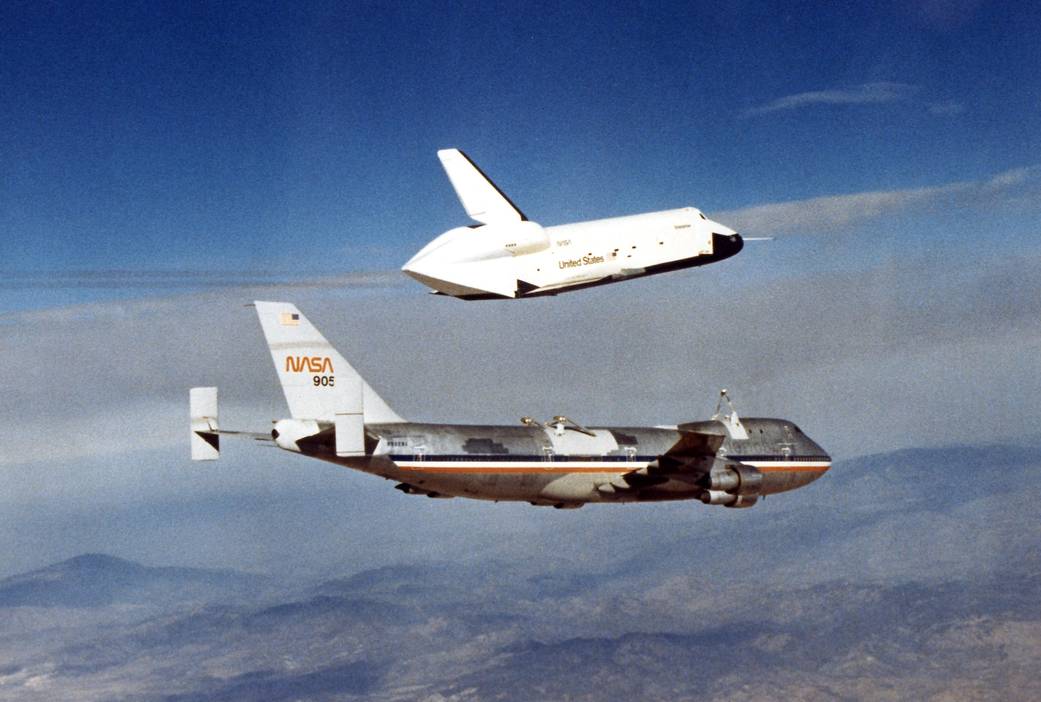
The Enterprise seconds after release from the Shuttle Carrier Aircraft. Fred Haise flew three gliding missions with his pilot Gordon Fullerton.
Jack Swigert went onto politics after leaving NASA in the mid-70's. He was elected to the US Congress as a Representative from Colorado in 1982, but died of cancer before he could take his office. He was only 51 years old.
Ken Mattingly's poor spaceflight luck only lasted for Apollo 13. He later flew as the Command Module Pilot during Apollo 16, orbiting the Moon while the original Apollo 13 backup crew of John W. Young and Charles Duke explored the surface. He spent the rest of the Seventies in managerial positions in the Space Shuttle program before he went on to command two shuttle missions, STS-4 in 1982 and STS-51-C in 1985. He was one of the only two Moon-flown astronauts to serve onboard the Shuttle - both of who flew on Apollo 16, incidentally.
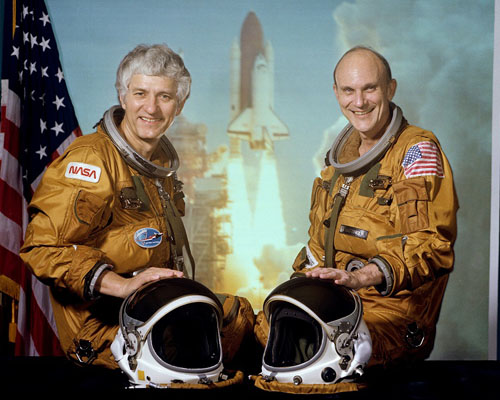
Ken Mattingly with pilot Hank Hartsfield posing for their STS-4 crew portrait. They are wearing the Ejection Escape Suits used during the first four shuttle missions.
Indeed, it was Ken Mattingly's Apollo 16 Commander, John W. Young, the Apollo 13 Backup Commander, who also went into the Shuttle program. He commanded Columbia in 1981 during the very first Shuttle mission which also saw the first time the US had launched a reusable spacecraft, as well as the first manned US launch utilizing solid-fueled boosters. The mission was a success. In 1983 he commanded STS-9, the first Spacelab orbital laboratory mission. He was joined in that mission by a fellow Apollo era astronaut and Skylab veteran Owen Garriot. The Challenger accident deprived Young of one more flight where he would have commanded the mission to deploy the Hubble Space Telescope. John W. Young died in 2018, as one of the most experienced US astronauts. He is the only person to have operated four different spacecraft in space - the Gemini capsule, the Apollo Command Module, the Lunar Module, and the Shuttle Orbiter.
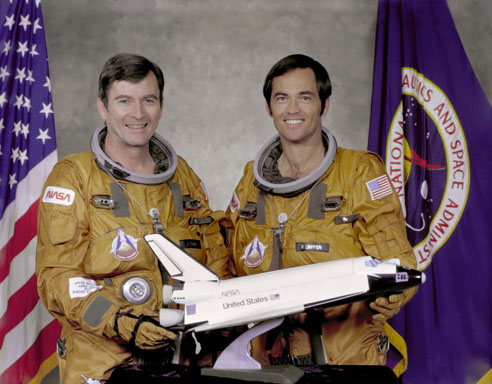
Commander John Young and Pilot Bob Crippen in their STS-1 crew photo.
The Apollo 13 CapComs, too, went on from being astronauts-in-waiting to achieving great triumphs in space, despite the truncated nature of the Apollo Program. Joe Kerwin was a member of the first crew to the Skylab space station in 1973. Not only was his 28-day flight the longest concurrent flight yet in NASA history, he was the first American physician to fly to space and conduct medical science there. Kerwin also took part in the first on-orbit repair EVA, when he and his mission Commander Pete Conrad released a stuck solar panel - apparently with the help of a wire saw from the medical kit, appropriately wielded by the doctor himself. Kerwin later served in many managerial roles in NASA.
Jack Lousma spent almost 60 days onboard the Skylab as the member of the second crew. In 1982 he commanded the third Space Shuttle test flight, STS-3. Vance Brand served as a backup crewmember for Skylab, including as the Commander of the potential Skylab Rescue mission should the crew need to be saved from orbit. He finally got his first chance in spaceflight in 1975 during the Apollo-Soyuz Test Project. He went on to fly three shuttle missions - STS-5, STS-41-B and STS-35. His last mission was in December, 1990 onboard Columbia. This was the last space mission flown by an astronaut who had trained for a lunar mission. Vance Brand was the Backup Command Module Pilot for Apollo 15. The last space mission flown by an Apollo era astronaut was STS-80 in 1996 where Skylab Backup Science Pilot Story Musgrave performed his sixth spaceflight.
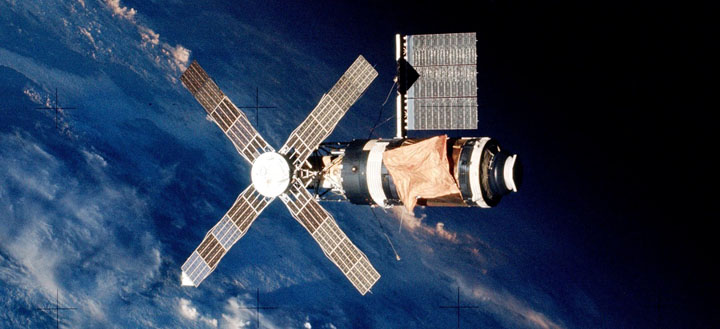
The first US space station, Skylab, photographed on Earth orbit in 1973. One solar panel is missing, and a gold-colored tarp deployed by the crew replaced the damaged thermal shield.
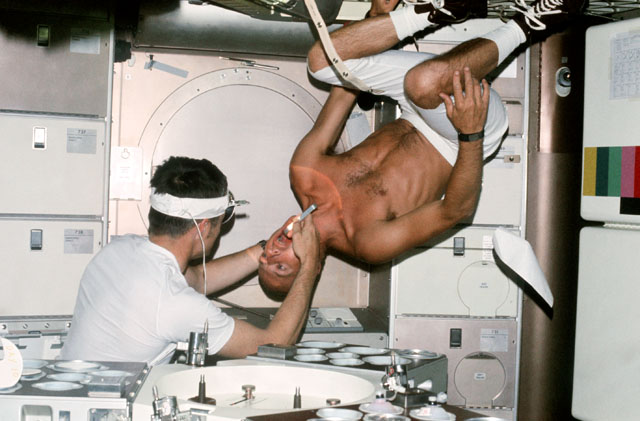
Science Pilot Joe Kerwin performs a dental exam on his Commander Pete Conrad onboard the Skylab.
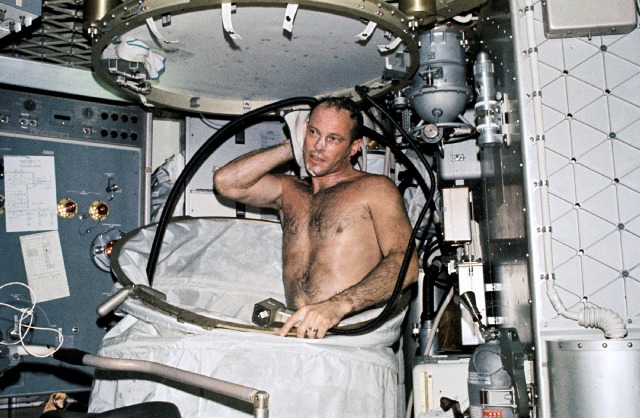
Pilot Jack Lousma enjoys one of the luxuries of Skylab unimaginable to earlier Apollo astronauts - a shower! This is certainly one of the most often reproduced Skylab images. The shower turned out to be a one-off innovation.
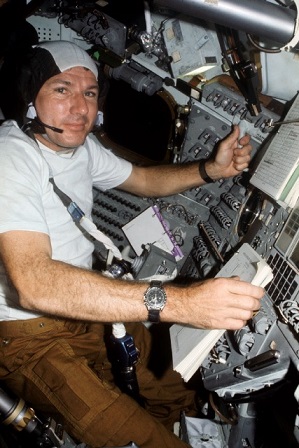
CMP Vance Brand gives a confident thumbs up during the last Apollo flight, the ASTP, in 1975.
Vance Brand was not the only astronaut to earn their wings during the ASTP. It was the first and sole space flight for Deke Slayton. He had been an astronaut in waiting since 1959, as a member of the original Mercury Seven selection, but had been grounded in 1962 due to heart problems before his first Mercury mission. His health was sufficient for the mission, however, where he successfully flew the historical rendezvous and docking with the Russian Soyuz spacecraft. The onboard recordings show that Deke enjoyed every moment of it. He died in 1993.
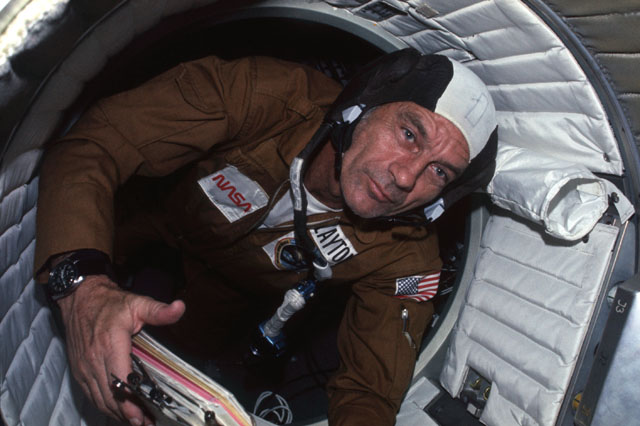
Deke Slayton slides through the Docking Module during ASTP, in 1975.
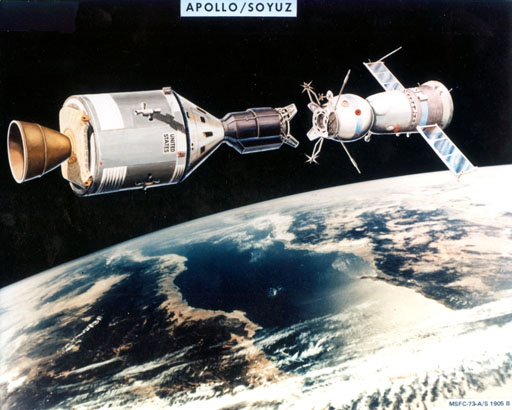
Artist impression of the Apollo and Soyuz spacecraft docking in orbit. Both spacecraft had been originally designed for the purpose of traveling to the Moon and back. While this was the end of Apollo operations, Soyuz continues to serve as the sole routine crewed transport to Earth orbit as of 2020.
The Enduring Legacy of "The Successful Failure"
Apollo 13 remains an often-cited example of crisis management, calm under duress, and the human triumph in a disaster situation. Although sometimes viewed in a romanticized manner, it has maintained public interest for the past 50 years since the events. As such as it has also been the subject of many books and filmed documentaries. Besides Jim Lovell's own memoirs, many other biographical books cover the accident, such as Gene Kranz' Failure is Not an Option and Deke! by Donald K. Slayton. Sy Liebergot's autobiography Apollo EECOM contains his recollections, from the unusual viewpoint of being perhaps the first person to see that something unfortunate had occurred. The Mission Control history Go,Flight! by Rick Houston covers the ground crew's actions in detail. More general Apollo histories such as Moon Shot (by Alan Shepard, Deke Slayton and Jay Barbree) and A Man to the Moon (by Andrew Chaikin) also cover the story. Besides original TV documentaries, television adaptations of a number of these books exist as well.
The 1995 Movie
Jim Lovell's autobiography, Lost Moon, was published in 1994, cowritten with author Jeffrey Kluger. The popularity of the book sparked renewed interest in the mission, including director Ron Howard who set out to produce it into a big-budget blockbuster movie, coming out in 1995. The movie had an all-star cast with Tom Hanks as Jim Lovell, Bill Paxton as Fred Haise, Kevin Bacon as Jack Swigert, Gary Sinise as Ken Mattingly, Ed Harris as Gene Kranz and Kathleen Quinlan in the role of Marilyn Lovell. Ron Howard's brother Clint Howard portrayed EECOM Sy Liebergot during key scenes, popularizing the depiction of Mission Control personnel. The production of the movie had access to NASA facilities and received the assistance of Apollo 15 astronaut Dave Scott, who served as a technical advisor. Set pieces of both Mission Control and the spacecraft were built to correspond closely to their real life counterparts. The scenes depicting weightlessness while Apollo 13 is in space were filmed as a combination of practical special effects - with the actors undulating their bodies while sitting on a sprung platform - and onboard the 'Vomit Comet', NASA's plane which could create a brief period of weightlessness by diving steeply. According to Jim Lovell's audio commentary on the film, the cast and crew spent "more time than any astronaut would care to" onboard the Vomit Comet to get all the shots of weightlessness needed. Lovell himself and his wife Marilyn Lovell appear in the movie as unspeaking extras. Taking part in the film gave Tom Hanks the enthusiasm to go on and produce - as well as appear - in the miniseries From Earth to the Moon that depicted the whole Apollo program.
Great care was taken to portray the events, locations and people in the movie as accurately as possible. Alterations were made in several respects that deviate from the known historical 'canon'. There has never been a claim that the film is a perfectly accurate historical documentary, rather than the drama film it is. Many artistic liberties were taken, including adding events so that the storytelling goals could be fulfilled. Viewers are encouraged to enjoy the movie for all that it is, and study the topic further if they wish to see what portions were altered for storytelling purposes. This should not detract from the film's impact as a movie that captures the spirit of the Apollo program, from the astronauts to the people in Mission Control.
The Other Apollo 13 movie
A made for television film was produced in 1974 about the flight of Apollo 13. Titled
"Houston, We've Got a Problem", it was filmed on location in Mission Control in Houston and even included some real flight controllers as non-speaking extras. Although featuring some real life people such as Gene Kranz as characters and set around the Mission Control's struggle to help Apollo 13, the movie's plot was mostly a domestic melodrama that had nothing to do with historical reality or attempting to record the true events in Houston. Jim Lovell was displeased by the ahistorical nature of the film and wrote a letter of complaint,
which can be viewed here.




